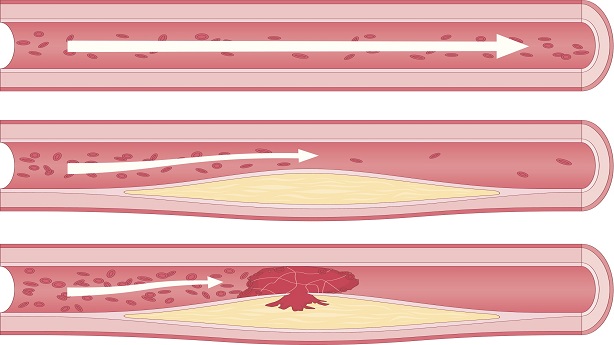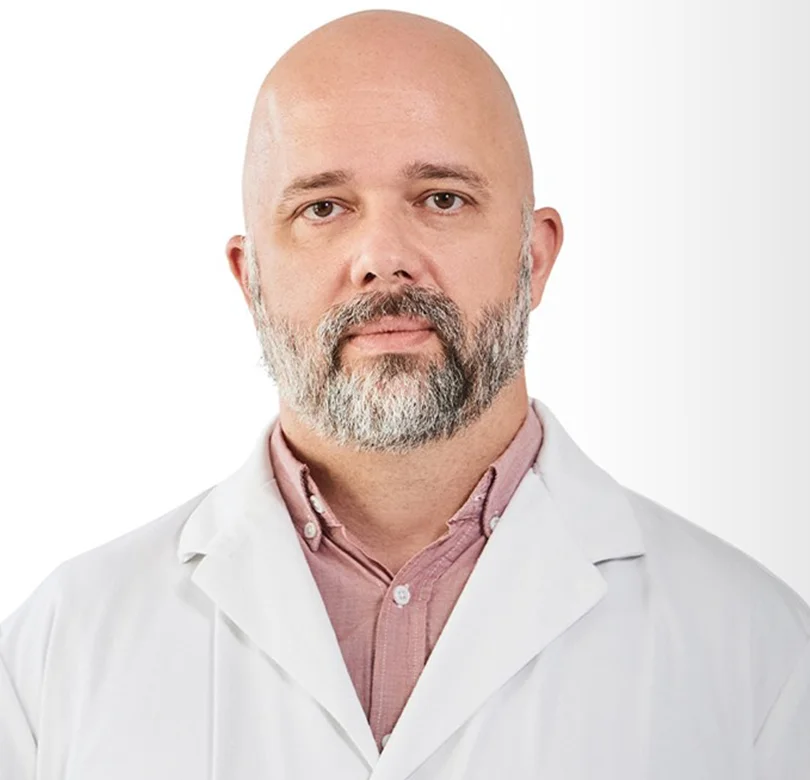What is atherosclerosis?
Blood flows through your arteries like water through a hose, delivering oxygen and nutrients to your organs. Atherosclerosis occurs when your arteries become clogged with fatty deposits (plaque), causing them to lose their elasticity and become narrower.
Plaque is a sticky mixture of fatty streaks that build up, making the walls of the arteries thick and hard. Over time, the artery narrows or gets blocked. This stops blood from flowing through the artery. The arteries in the heart (coronary arteries), neck (carotid arteries) and the legs are affected most often.
A plaque can also break apart. If this happens, a blood clot (thrombus) forms at the break and blocks blood flow. Or the blood clot can move through the bloodstream, blocking blood flow to organs.

Atherosclerosis usually starts early in life. Many people have plaque by middle age. Mild plaque often doesn’t affect blood flow very much. Atherosclerosis doesn’t usually have any symptoms until the artery is blocked by at least half.
Complications from atherosclerosis
Depending on which artery is blocked, atherosclerosis can cause several health problems.
Coronary artery disease and angina
When the major arteries to your heart become affected by atherosclerosis, it can lead to coronary artery disease (CAD) or angina. The heart is a muscle and needs a supply of oxygen-rich blood like every other muscle in the body. If one or more of the coronary arteries becomes narrowed or blocked, blood flow to the heart can slow down or stop. Coronary artery disease can cause a heart attack.
If plaque forms in the very small arteries of the heart, it can cause coronary microvascular disease. Microvascular angina can cause chest pain even when tests don’t show any blockages in the bigger arteries.
Carotid artery disease
If the arteries in your neck become narrow or blocked, blood flow to the brain can slow down or stop. A piece of plaque can break off, travel through the arteries to the brain, block blood vessels in the brain and cause a stroke or mini-stroke (TIA).
Peripheral arterial disease (PAD)
If the arteries in your legs or arms become narrow or blocked, you may develop peripheral arterial disease (PAD), leading to cramping muscular pain while walking or during exercise. Pain in the leg is usually the first sign of PAD, but PAD can occur elsewhere in the body. It may also affect the arteries supplying blood to your kidneys or stomach, increasing the risk of organ damage.
Learn more about PAD from the American Heart Association and the Vascular Disease Foundation.
Aneurysm
Atherosclerosis can cause an aneurysm, which is a bulge in a weakened area of your artery wall. The bulge can burst and cause internal bleeding in the brain. It can be fatal when an aneurysm in the largest artery (the aorta) bursts.

Dr. Heit thinks immune system could hold key to preventing heart attacks.

Who is at risk?
Risk factors for atherosclerosis include:
- high blood pressure
- high cholesterol levels
- diabetes
- dyslipidemia (unhealthy level of fats in the blood)
- chronic kidney disease
- unhealthy weight
- unhealthy diet
- family history of heart disease
- not enough exercise
- smoking
- depression
Find out more about how you can reduce your risk of developing atherosclerosis.
Causes
Atherosclerosis is a slow, progressive condition that may begin as early as childhood. Its causes are complicated and not completely understood, but atherosclerosis is thought to start when the inner lining of the artery becomes damaged. The damage can be caused by:
- high blood pressure
- high cholesterol and triglycerides (a type of fat) in the blood
- high levels of insulin in the blood from diabetes
- chemicals from smoking tobacco
The blood vessel wall reacts to this injury by depositing a plaque made up of fatty substances, cholesterol, calcium and other substances on the inner lining of the artery. Gradually, the blood vessels narrow, making it harder for blood to flow.
Symptoms
Sometimes atherosclerosis causes no symptoms until it is advanced enough to block a large part of an important blood vessel. If the blockage occurs in an artery of the heart (coronary artery), it will cause angina (chest pain). As it progresses, atherosclerosis in the arteries of the heart may cause a heart attack or if it develops in the brain, it can cause a stroke. If the blockage is in the legs, it can cause leg cramps during exercise or walking.
Diagnosis
Your healthcare provider will review your medical history, give you a complete physical exam and run blood tests. Atherosclerosis tests include:
- physical exam
- ankle/brachial index This test compares the blood pressure in your ankle with the blood pressure in your arm to see how well your blood is flowing. This test can help diagnose PAD.
- blood tests
- urine tests
- doppler ultrasound
- electrocardiogram (ECG/EKG)
- exercise stress test
- angiography
- heart MRI
- nuclear image tests Single photon emission computed tomography (SPECT) scans and positron emission tomography (PET) scans let your doctor see how well your blood is flowing. Both use a radioactive substance and a special camera to create a 3-D image of your internal organs. PET scans use less radiation and can produce higher quality images that can detect small interruptions in blood flow.
Blood tests to measure cholesterol and triglycerides (lipids) are used to find out if healthy people are at risk for atherosclerosis. Lipid screening is recommended for people over 40, and for people who have risk factors regardless of their age. Ask your family physician if you are eligible for lipid screening, if you are not being screened already.
Treatment
Atherosclerosis can be managed with lifestyle changes, medications, surgery or other procedures.
Lifestyle
You can lower your risk of other heart diseases and stroke by knowing and controlling your blood pressure, diabetes and blood cholesterol. It is also important to lead a healthy lifestyle:
- Be smoke-free.
- Be more active.
- Eat a healthy balanced diet – there are some specific diets you can follow that have been proven to reduce the risk of heart disease.
- Aim for a healthy weight.
- Drink less alcohol.
- Manage stress.
Talk to your doctor about the lifestyle changes that will benefit you the most.
Medications
You may be prescribed medication to:
- Reduce fats and cholesterol in your blood
- Control your blood pressure
- ACE inhibitors (Angiotensin converting enzyme)
- beta-blockers
- calcium channel blockers
- diuretics
- Reduce your risk of developing a clot
Surgery
If you have severe atherosclerosis, your doctor may suggest surgery to manage your condition. Atherosclerosis procedures include:
- Percutaneous coronary intervention (PCI or angioplasty with stent) A balloon (stent) is inserted into the narrowed vessel and inflated to widen the vessel.
- Carotid endarterectomy surgery to remove plaque from the carotid artery.
- Coronary artery bypass surgery Blood is redirected around the narrowed or blocked artery.
Living with atherosclerosis
Cardiac rehabilitation is a personalized program of exercise, education and counselling to help you recover from heart disease and reduce your risk of having other heart problems in the future. Talk to your doctor about how to find a program in your area or contact your public health department or hospital. The Canadian Association of Cardiac Rehabilitation also has a cardiac rehabilitation program directory to help you find a program in your community.
Related information
Living Well with Heart Disease (PDF)
A quick guide to your vascular system – the foundation of your heart and brain health.
This short animation from the British Heart Foundation will give you a quick look at how high cholesterol, high blood pressure and smoking can lead to blocked arteries (blood vessels). And how blocked arteries can lead to a heart attack or a stroke.
